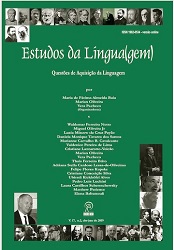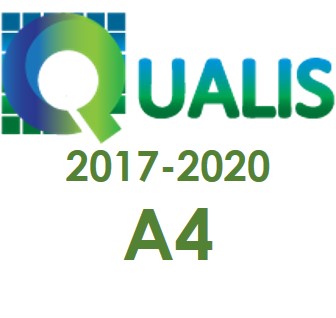Melodías de niño: interferencia fonológica griego-inglés
DOI:
https://doi.org/10.22481/el.v17i2.5347Palabras clave:
Bilingüismo; Adquisición del Lenguaje; Prosodia.Resumen
En este artículo, voy a discutir la interferencia fonológica en términos de la teoría psicolingüística y fonológica. Para ello, utilizo datos naturalísticos de una niña bilingüe griego-inglés de 2;7 años. Es decir, se trata de un par de idiomas poco investigado con respecto al bilingüismo. El objetivo final es descifrar los procesos psicolingüísticos y lingüísticos involucrados en la interferencia fonológica del niño en un nivel cualitativo (o nivel melódico), también respaldado por pruebas cuantitativas. Se analiza la interacción fonológica en las fonologías en desarrollo del niño en un contexto lingüístico poco representado: uno de los idiomas (inglés) se adquiere de forma exógena y, por lo tanto, se caracteriza por una exposición comprometida en términos de cantidad y calidad de información. Los resultados sostienen la manifestación de la interferencia fonológica tanto en la superficie como en los niveles subyacentes de algunas unidades melódicas en los idiomas de los bilingües, pero no en todo el ámbito melódico. Los análisis subsiguientes iluminan la interacción indiscutible de múltiples desarrollos.
Descargas
Citas
BABATSOULI, E. (forthcoming2). Prolegomena. In BABATSOULI, E. (Ed.), On under-reported monolingual child phonology. Bristol, UK: Multilingual Matters.
BABATSOULI, E. A phonological assessment test for child Greek. Clinical Linguistics and Phonetics. 2019.
BABATSOULI, E. Bilingual development of theta in a child. Poznan Studies in Contemporary Linguistics, v. 53, n.2, p. 157-195. 2017.
BABATSOULI, E. Technologies for the study of speech: Review and an application. Themes in Science and Technology Education, v. 8, n. 1, p. 17-32, 2015.
BABATSOULI, E; BALL, M. J. (forthcoming). Introduction. In BABATSOULI, E; BALL, M. J. (Eds.), An anthology of bilingual child phonology. Bristol, UK: Multilingual Matters.
BABATSOULI, E; INGRAM, D. Prologue. In BABATSOULI, E; INGRAM, D (Eds.), Phonology in protolanguage and interlanguage (pp. 1-23). Sheffield, UK: Equinox Publishing, 2018.
BABATSOULI, E; KAPPA, I. Transfer of Greek palatals in L2 English. In WREMBEL, M; KUL, M.; DZIUBALSKA-KOŁACZYK, K (Eds.), Achievements and perspectives in the acquisition of second language speech: New Sounds Frankfurt: Peter Lang, 2010. p. 27-42.
BABATSOULI, E; NICOLADIS, E. The acquisition of English possessives by a bilingual child: Do input and usage frequency matter? Journal of Child Language, v. 46, n.1, p. 170-183, 2019.
BERNARDINI, P; SCHLYTER, S. Growing syntactic structure and code-mixing in the weaker language: the Ivy Hypothesis. Bilingualism: Language and Cognition, v. 7, n.1, p. 49–69, 2004.
BRANNEN, K. The role of perception in differential substitution. Canadian Journal of Linguistics - Revue Canadienne de Linguistique, v. 47, p. 1-20, 2002.
BRIÈRE, E. J. A Psycholinguisitc study of phonological interference. The Hague/Paris: Muton. 1968.
BUNTA, F; DAVIDOVICH, I; INGRAM, D. The relationship between the phonological complexity of a bilingual child’s words and those of the target languages. International Journal of Bilingualism, v. 10,. 1, p. 71-88. 2006.
ECKMAN, F. R; ELREYES, A; IVERSON, G. K. Some principles of second language phonology. Second Language Research, v. 19, n. 3, p. 169-208, 2003.
EDWARDS, J. G. H.; ZAMPINI, M. L. (Eds.) (Phonology and second language, Philadelphia: John Benjamins, 2008.
FLEGE, J. E; DAVIDIAN, R. Transfer and developmental processes in adult foreign language speech production. Applied Linguistics, v. 5, n. 3, p. 23-347, 1984.
GASS, S. M; SELINKER, L. (Eds.) Language transfer in language learning. Cambridge, MA: Newbury House, 1982.
GROSJEAN, F. Studying bilinguals, Oxford: Oxford University Press, 2008.
GROSJEAN, F. (2012). An attempt to isolate and then differentiate transfer and interference.International Journal of Bilingualism, v.16, n. 1, p. 11-21, 2012.
GRUNWELL, P. The development of phonology. First Language, n. 3, p. 161-191, 1981.
HAMBLY, H; ET AL. The influence of bilingualism on speech production: A systematic review. International Journal of Language and Communication Disorders, v. 48, p. 1-24, 2013.
INGRAM, D. e al. The acquisition of word-initial fricatives and affricates in English by children between 2 and 6 years. In YENI-KOMSHIAN, G. H; KAVANAUGH J. F; FERGUSON, C. A. Child phonology, Vol. I: Production. New York: Academic Press, 1980. p. 169-192
JAKOBSON, R. Child language, phonological universals and aphasia. The Hague: Mouton. 1941/1968.
KEHOE, M. Crosslinguistic interaction in early bilingual phonology: A critical review. In Babatsouli, E; Ingram, D. (Eds.), Phonology in protolanguage and interlanguage . Sheffield, UK: Equinox Publishing, 2018. p. 49-75.
LEOPOLD, W. F. Speech development of a bilingual child: A linguist’s record. Evanston, IL: Northwestern University Press, 1949.
LLEÓ, C; CORTÉS, S. Modeling the outcome of language contact in the speech of German-Spanish and Catalan-Spanish bilingual children, International Journal of the Sociology of Language, 221, 101-125, 2013.
MAJOR, R. C. Phonological differentiation of a bilingual child. Papers in Psycholinguistics and Sociolinguistics. Working Papers in Linguistics, v. 22, p. 88-122, 1977.
MAJOR, R. C. Transfer in second language phonology. In J. G. H. Edwards & M. L. Zampini (Eds.), Phonology and second language acquisition Philadelphia/Amsterdam: John Benjamins, 2008. p. 63-94.
MACWHINNEY, B. The CHILDES project: Tools for analyzing talk. Mahwah, NJ: Lawrence Erlbaum, 2000.
MAGOULA, E. The acquisition of the phonological system in Modern Greek: The case of consonants. Unpublished doctoral dissertation. University of Athens, Greece, 2000.
MCLEOD, S. The international guide to speech acquisition. Clifton Park, NY, Thomson Delmar Learning, 2007.
MCLEOD, S; BLEILE, K. Neurological and developmental foundations of speech acquisition. Invited seminar presentation at the American Speech and Hearing Association Convention, November 2003, Chicago, IL.
MEISEL, J.‘Early differentiation of languages in bilingual children’, in K. Hyltenstam & L. Obler (eds.), Bilingualism across the lifespan: Aspects of acquisition, maturity and loss. Cambridge: Cambridge University Press, 1989. p.13-40.
MOSKOWITZ, A. I. Acquisition of phonology. Unpublished doctoral issertation, University of California, Berkeley, USA, 1971.
MOULTON, W. (1962). Toward a classification of pronunciation errors. Modern Language Journal, n. 46, p. 101-109, 1962.
Nespor, M. Phonology. Athens: Patakis Publication (adapted for Greek by A. Ralli & M. Nespor), 1999.
OHALA, J; RIORDAN, C. Passive vocal track enlargement during voiced stops. Report of the Phonological Laboratory UC Berkeley, n. 5, p. 78-87, 1980.
ODLIN, T. Cross-linguistic influence. In DOUGHTY, C; LONG, M. H. (Eds.), The handbook of second language acquisition. Cambridge, MA: Blackwell, 2008. p. 436-486.
PARADIS, J. Beyond ‘One system or two’: Degrees of separation between languages of French - English bilingual children. In DÖPKE, S (Ed.), Cross-linguistic structures in simultaneous bilingualism. Amsterdam/Philadelphia: John Benjamins, 2000. p. 175-2000.
PARADIS, J; GENESEE, F.‘Syntactic acquisition in bilingual children: Autonomous or inderdependent?’ Studies in Second Language Acquisition, v. 18, n. 1-25, 1996.
PIENEMANN, M; KEßLER, J. Measuring bilingualism. In: AUER, P; WEI, L. (Eds.) Handbook of multilingualism and multilingual communication The Hague: Mouton de Gruyter, 2007. p. 247-267.
PRINCE, A; SMOLENSKY, P. Optimality theory: Constraint interaction in generative grammar. Oxford: Basil Blackwell, 2004.
SMIT, A. B. Phonologic error distributions in the Iowa-Nebraska articulation norms project: Consonant singletons. Journal of Speech and Hearing Research, v. 36, p. 533-547, 1993.
SMITH, J. Phonological augmentation in prominent positions. Unpublished doctoral dissertation. University of Massachusetts, Amherst, USA, 2002.
SMITH, N. V. The acquisition of phonology: A case study. Cambridge Studies in Linguistics 25, Cambridge: Cambridge University Press, 1973.
TEMPLIN, M. Certain language skills in children: Their development and interrelationships. 1957. Monograph. The University of Minnesota Press, 1957.
VOLTERRA, V; TAESCHNER, T. The acquisition and development of language by bilingual children. Journal of Child Language, Cambridge, v. 5, p. 311-326, 1978.
WEINREICH, U. Languages in contact: findings and problems. Mouton: The Hague, 1953.
WEINREICH, U. Explorations in semantic theory. Mouton: The Hague, 1966.
Descargas
Publicado
Número
Sección
Licencia

Estudos da Língua(gem) está bajo una Licencia Creative Commons Atribución 4.0 Internacional.
Los autores que publican en el periódico Estudios de la Lengua (g) concuerdan con los siguientes términos:
La revista Estudios del Lenguaje mantiene los derechos de autor de las contribuciones publicadas. Estos derechos incluyen la publicación de la contribución y pondrá a disposición su contenido gratuitamente a través del portal













